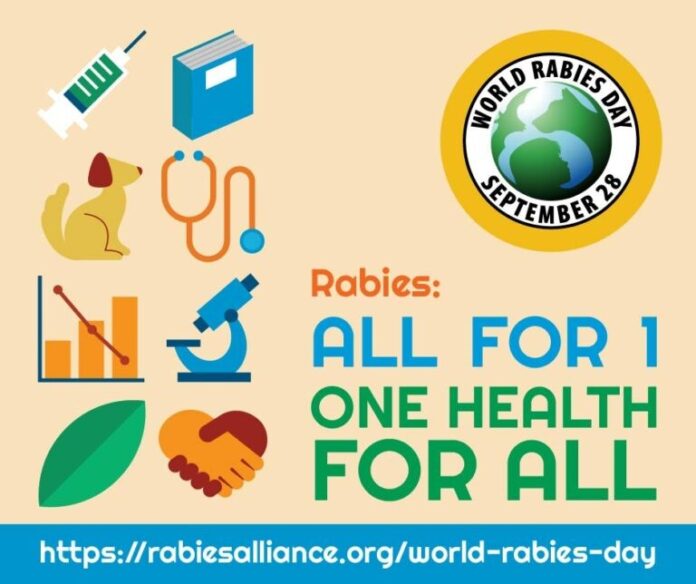Title: One World, One Health: Preventing Zoonoses
Charu Singh- 4 th year B.V.Sc&A.H
ANDUAT, Kumarganj, Ayodhya (U.P.)
Introduction
Rabies, a viral disease that affects mammals, including humans, has haunted humanity for centuries. While it remains a deadly threat, it’s important to recognize that rabies is entirely preventable. With the global community’s united efforts, we are inching closer to achieving the ambitious goal of “Rabies: All for 1, One Health for All.” In this comprehensive essay, we will explore the multifaceted facets of rabies, its prevention, the One Health approach, global initiatives, challenges, education, and the path forward.
1.Understanding Rabies
Rabies is a virus that has left a long and dark history in its wake. It is primarily transmitted through the saliva of infected animals, most commonly through bites. Once symptoms appear, rabies is almost universally fatal. This chapter provides an in-depth understanding of rabies, its history, transmission, and the disease’s impact on both humans and animals. We will discuss the virus’s biology, its symptoms, and the progression of the disease in infected individuals.
2.The One Health Approach
The concept of the “One Health” approach recognizes that the health of humans, animals, and the environment is interconnected. In the context of rabies, it means addressing the disease at its source – in animals – to prevent transmission to humans. This chapter delves into the significance of the One Health approach in addressing global health challenges like rabies. We explore how the interconnectedness of human, animal, and environmental health informs strategies for rabies prevention. The chapter also highlights the critical role of domestic animals, primarily dogs, in rabies transmission and the importance of their vaccination.
3.Global Initiatives Against Rabies
Various global organizations, including the World Health Organization (WHO), the World Organization for Animal Health (OIE), and the Food and Agriculture Organization (FAO), have joined forces to combat rabies. Their goal is ambitious but attainable: eliminate human deaths due to rabies by 2030. This chapter examines the efforts of these organizations in the fight against rabies. We highlight successful mass vaccination campaigns, improved access to post-exposure prophylaxis, and awareness-raising initiatives aimed at eliminating human deaths from rabies.
4.Challenges in Eradicating Rabies
Rabies eradication is a monumental task, and challenges persist in the battle against the disease. Limited resources in low-income countries, cultural beliefs, and underreporting are just a few of the hurdles. This chapter explores these challenges in detail and discusses strategies to overcome them. By addressing these obstacles, we can make significant progress towards a rabies-free world.
5.The Role of Education and Awareness
Education plays a pivotal role in rabies prevention. Communities must be informed about the risks associated with rabies and the importance of responsible pet ownership. Furthermore, healthcare professionals need to be trained in recognizing and treating rabies cases promptly. Public awareness campaigns are essential to dispel myths and encourage vaccination. This chapter underscores the importance of education and awareness in the fight against rabies.
6.Beyond Rabies: One Health for a Sustainable Future
Rabies serves as a compelling example of the One Health approach in action, but its principles extend beyond this one disease. In this chapter, we explore how adopting a holistic approach to health can lead to sustainable solutions for other zoonotic diseases and broader environmental and public health challenges. By recognizing the interconnectedness of all living organisms, we can create a healthier and more sustainable future for everyone.
Conclusion
In conclusion, “Rabies: All for 1, One Health for All” is not just a vision; it’s an attainable goal with the collective effort of the global community. By examining the intricacies of rabies, the One Health approach, global initiatives, persistent challenges, and the importance of education, we reinforce the importance of collaboration and awareness in the fight against rabies. Ultimately, our efforts against rabies pave the way for a healthier, safer world for all, exemplifying the power of unity and shared responsibility in public health.
References
- World Health Organization (WHO). (2021). Rabies. [Link](https://www.who.int/health-topics/rabies#tab=tab_1)
- World Organization for Animal Health (OIE). (2021). Rabies. [Link](https://www.oie.int/en/animal-health-in-the-world/rabies-portal/about-rabies/)
- Hampson, K., Coudeville, L., Lembo, T., Sambo, M., Kieffer, A., Attlan, M., … & Dodet, B. (2015). Estimating the global burden of endemic canine rabies. PLoS Neglected Tropical Diseases, 9(4), e0003709. [Link](https://journals.plos.org/plosntds/article?id=10.1371/journal.pntd.0003709)
- Rupprecht, C. E., Barrett, J., Briggs, D., Cliquet, F., Fooks, A. R., Lumlertdacha, B., … & Wandeler, A. I. (2008). Can rabies be eradicated? Development of a strategy for the global elimination of canine rabies. Expert Review of Vaccines, 7(6), 761-771. [Link](https://www.tandfonline.com/doi/full/10.1586/14760584.7.6.761)
- World Health Organization (WHO). (2018). WHO Expert Consultation on Rabies: Third Report. [Link](https://apps.who.int/iris/bitstream/handle/10665/272364/9789241210218-eng.pdf?ua=1)
- Global Alliance for Rabies Control (GARC). (2021). About Us. [Link](https://rabiesalliance.org/about)
- Zinsstag, J., Schelling, E., Roth, F., Bonfoh, B., de Savigny, D., & Tanner, M. (2007). Human benefits of animal interventions for zoonosis control. Emerging Infectious Diseases, 13(4), 527-531. [Link](https://wwwnc.cdc.gov/eid/article/13/4/06-1490_article)
- World Health Organization (WHO). (2021). Rabies vaccines: WHO position paper. [Link](https://www.who.int/wer/2018/wer9335/en/)
- Lardon, Z., Watier-Grillot, S., & Chatelain, E. (2016). Combining social sciences and epidemiology to improve the prevention of rabies in humans: the case of France. PLoS Neglected Tropical Diseases, 10(7), e0004825. [Link](https://journals.plos.org/plosntds/article?id=10.1371/journal.pntd.0004825)
- Grace, D., Mutua, F., Ochungo, P., Kruska, R., Jones, K., Brierley, L., … & Lapar, M. L. (2012). Mapping of poverty and likely zoonoses hotspots. Zoonoses Project 4. Report to the UK Department for International Development. [Link](https://cgspace.cgiar.org/handle/10568/21161)
These references provide additional information and sources for further reading on the topic of rabies, its prevention, and the One Health approach.


